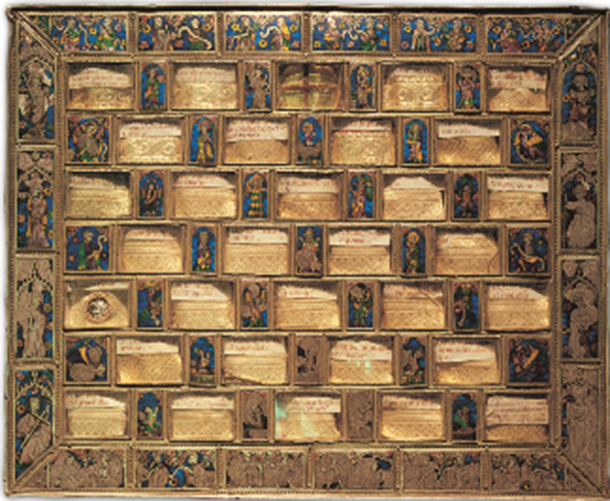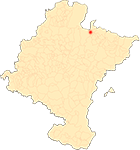Roncesvalles
By Javier Martínez de Aguirre Aldaz
Charlemagne's chess
An exceptional piece is the so-called Charlemagne's Chess set. According to tradition, the emperor was playing on it when he heard Roland's call announcing the fatal defeat of the Frankish army. In reality it is a reliquary in which enamelled squares alternate with others containing relics with their real names protected by glass.
Its artistic quality derives on the one hand from the magnificent translucent enamels and on the other from the impressive iconographic programme arranged around a central painting reserved for Christ of the Stigmata, often associated in the Gothic period with the Last Judgement. He is surrounded by the intercessors, the Virgin and Saint John, and angels carrying the instruments of the Passion. In the two lower rows, various figures emerge from the tombs, called by trumpeter angels; they are the resurrected on the Day of Judgement. In the central part we find the symbols of the Evangelists: winged lion and bull, angel and eagle (respectively Mark, Luke, Matthew and John), two prophets, two seraphim, St. Catherine, St. Margaret and St. Mary Magdalene. In the upper row we see an image of God the Creator with the world in his hands, the Annunciation and a holy bishop. In the vertical bands of the border, several apostles can be recognised: on the left from top to bottom: St Paul with the sword, St John with the palm, St Bartholomew with the knife and St Andrew with the cross; and on the right St Peter with the keys, St James dressed as a pilgrim and St Jude Thaddeus with the mace. More figures with books and phylacteries, some with Jewish caps, fill the horizontal bands of the border, whose lower central part narrates the stoning of St Stephen. The texts identifying the relics are not placed according to their proximity to the corresponding figures.
The MOP mark reveals that the reliquary was made in Montpellier, possibly in the mid-14th century. The enamelling shows traces of the Midi school. The absence of a silversmith's mark, required by ordinances from 1355, provides a terminus ante quem.
Dectot, X., "Yacente de Sancho VII el Fuerte", in Bango Torviso, I.G. (dir. cient.), Sancho el Mayor y sus herederos. El linaje que europeizó los reinos hispanos, Pamplona, 2006, pp. 371-373.
Fernández-Ladreda, C., Imaginería medieval mariana en Navarra, Pamplona, 1989.
Fernández-Ladreda, C. (Dir.), Martínez Álava, C., Martínez de Aguirre, J. and Lacarra Ducay, M.C., El arte gótico en Navarra, Pamplona, 2015.
Fuentes y Ponte, J., report histórica y descriptiva del santuario de Nuestra Señora de Roncesvalles, Lérida, 1880.
García Gainza, M.C., Orbe Sivatte, M. and Domeño Martínez de Morentin, A., Catalog Monumental de Navarra IV**. Merindad de Sangüesa, Pamplona, 1992.
Ibarra, J., History of Roncesvalles. Art. History. Legend, Pamplona, 1936.
Lambert, E. Roncevaux", Bulletin Hispanique, XXXVII (1935), pp. 417-436.
Martínez de Aguirre, J. (coord.), Enciclopedia del Románico en Navarra, Aguilar de Campoo, 2008, vol. III, pp. 1216-1224.
Martínez de Aguirre, J., Gil Cornet, L. and Orbe Sivatte, M., Roncesvalles. Hospital and sanctuary on the Camino de Santiago, Pamplona, 2012.
Miranda García, F. and Ramírez Vaquero, E., Roncesvalles, Pamplona, 1999.
Peris, A., "El Ritmo de Roncesvalles: estudio y edición", Cuadernos de Filología Clásica. Latin Studies, 11 (1996), pp. 171-209.
Pons Sorolla, F., "project de obras de restauración en la capilla del Sancti Spiritus de la Real Colegiata de Roncesvalles (Navarra)", Príncipe de Viana, XXXIX (1978), pp. 59-77.
Soria i Puig, A., The Road to Santiago. II. Stations and signs, Madrid, 1992.
Torres Balbás, L. La iglesia de la hospedería de Roncesvalles", Príncipe de Viana, VI (1945), pp. 371-403.
Thuile, J., L'Orfèvrerie en Languedoc du XIIe au XVIIIe siècle. Généralité de Montpellier, Montpellier, 1966.












